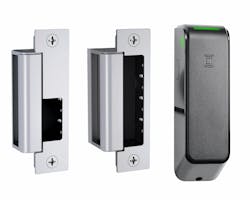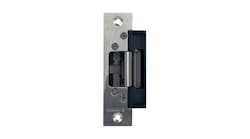Savvy Strikes Safely Secure Openings
Electric strikes continue to change with technology, yet still represent the original foundation of security – which is keeping intruders out of the premises and layering protection. Easier to deploy, reliable and dependable, electric strikes include more capabilities and utilities, focusing on features that simplify installation while adding the latest aesthetic finishes to match door frames. There’s also the ability to customize housings with logos or other UV printing on some strikes.
Electric strikes offer many different price points and the best value for superior locking performance and security. These devices are versatile and now incorporate embedded installation options to fit and customize the device to the door. All-glass openings? No problem! Preload pressure? No problem! Need to integrate online access control? With today’s electric strikes, you can expand your electric strike project to all kinds of openings.
High performers in every environment
Electric strikes are an integral part of electromechanical door systems, offering versatility, durability and longevity. They also provide a perfect pathway to shift from mechanical to electrified access control. (If you move to electrified hardware, remember that the opening’s hardware must meet all code requirements.)
Electric strikes are an exceptional value for the security performance they offer. They are available in price points and security levels that exceed traditional locksets. The cost to deploy has been carefully considered by manufacturers and strikes have been designed with flexible installation and programming features that save time and money in the field. With auto-sensing capabilities, circuit protection and energy-saving motorized actuators, electric strike deployments stand ready to satisfy both new construction and retrofit applications.
Making the fit with all-glass doors
No discussion on electric strikes would be complete without addressing the growing number of glass doors specifications. For open lighting and overall aesthetics, all-glass entrances have captured the attention of designers and specifiers.
Making use of what’s existing at the installation site, or being able to adjust the product to match the environment represents significant time and cost savings, especially for glass openings. Traditionally, surface mount electric strikes for both single and double glass doors required the installer to match and select the most common OEM prep kit. New options also allow systems integrators and installers to readily retrofit an electric strike using the existing header prep with retrofit options and field replaceable components. These electric strikes come with built-in integrated adjustability and field installable options, while being designed with the strength and durability to meet UL outdoor ratings.
Electric strikes for glass openings work with tubular, vertical rod exit devices. Low profiles offer simplified installation within the existing mechanical prep without the need to cut the frame: simply drill one hole for power and mount the strike. Adaptable voltage sensing technology allows the installer the flexibility of using any voltage from 12 through 24 volts, removing any pigtail guesswork. Other features include interchangeable faceplates and accessories to match the opening.
While looks are important, security for these openings needs to be a critical consideration and not an afterthought. In the past, customers were often relegated to using a maglock or drop bolt in a fail-safe application only, because there was no fail-secure solution for this type of opening. (Fail safe means when no power is applied the door is unlocked; fail secure keeps the door locked, even without power.)
Fortunately, there are new devices designed from the ground up specifically for glass. They offer a mechanical top latch which can work in conjunction with an electric strike for a fail-secure locking solution. In addition, they include familiar features found on standard openings such as mechanical dogging and key override. Users can be assured that the opening is secure and if power is cut, the area remains locked.
Monitoring strike and latch status
For additional versatility, electric strikes are available with strike and latch monitoring status. Full monitoring setups with electric strikes can show when a door is shut, the latch is inside the strike and the strike itself is locked, ensuring a fully secure opening and no compromise. These strikes can be tied into the access control panel and integrated with software, with stakeholders receiving real-time updates on the current state of the devices. Installers can apply monitoring as needed from the installed strike with dynamic integrated adjustability and field configurable options compatible with any cylindrical, mortise or rim exit device.
Monitoring keeps end users up to speed on system performance. In addition, it can meet specific applications, such as controlling and monitoring public restrooms. For example, when the user throws the deadbolt in a public restroom, it activates the monitoring switch and cuts the electric strike’s connection to power so no one can enter until the occupant leaves the space and the strike reverts to active status.
Preload capable for door challenges
Strikes with preload functionality provide a fine balance of strength and slip for door openings such as aluminum or hollow metal doors and are one of the fastest growing categories for electric strikes. Preload is characterized as pressure exerted on doors often due to HVAC or thermal expansion, warping or misaligning hardware, which can disable common electric strikes.
Strikes can adeptly meet the challenges of preloaded doors using cylindrical latch bolts and rim exit latch bolts. An in-frame feature lets systems integrators adjust the electric strike opening to properly fit the horizontal position of the keepers after installation. The preload release function allows the electric strike to operate smoothly under various loads on the door no matter the weather or ambient conditions, or openings with weather stripping that could restrict standard electric strikes.
Electric strikes can also accommodate fire-rated latch bolt applications, covering preload conditions caused by a warped or misaligned door, a smoke seal or other condition causing the door to bind.
Wireless retrofit with BLE and NFC
Wireless strikes have also emerged strong for systems integrators looking to add security to an opening where running wires is not an option, like a historical building or other structure where drilling is impossible or prohibited.
Connected, wireless strikes offer management and scheduling flexibility of individual strikes, operating with a wireless central hub that communicates with Bluetooth or NFC. Wireless integrated electric strikes and card readers make it simple to retrofit an opening with real-time online access control. Electric strikes when paired with wireless technology provide even more affordable access control retrofit options for remote control and monitoring. These strikes are available in both monitored and non-monitored options.
Electric strikes set a new standard in the industry by offering dynamic integrated adjustability and field configurable options compatible with any cylindrical or mortise lock. The modular design of the platform makes stocking and installing easier with interchangeable faceplates and accessories. For the first time, the aesthetics of an electric strike are complimentary to other surrounding door hardware and blend in with the opening.
Electric strikes offer outstanding versatility in access control applications. Designs that work with electric strikes include cylindrical locksets; mortise locks; panic exit devices; narrow stile latch bolts; unit locks; deadbolts; and hook bolts. Look to these high-performance entrance control devices to fit a wide range of vertical markets and end-user customers.
Matt Branson and Trevor Maness are Product Managers for ASSA ABLOY’s Electromechanical Solutions Group in Phoenix, Arizona.







